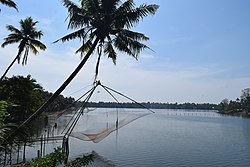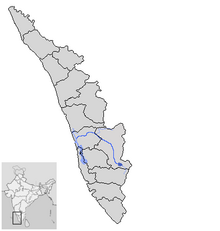| Periyar | |
|---|---|
 Fishing nets over Periyar | |
 | |
| Location | |
| Country | India |
| State | Kerala |
| Cities | Kochi, Neriamangalam, Kalady, Malayattoor |
| Physical characteristics | |
| Source | Chokkampatti Mala, Periyar Tiger Reserve |
| • location | Kerala, India |
| Mouth | Arabian Sea, Vembanad Lake |
• location | Kerala, India |
| Length | 244 km (152 mi)[1] |
| Basin size | 5,398 km2 (2,084 sq mi) |
| Discharge | |
| • location | mouth |
| • average | 295 m3/s (10,400 cu ft/s) |
| Discharge | |
| • location | Kalady (1980–2004)[2] |
| • average | 223 m3/s (7,900 cu ft/s) |
| Basin features | |
| Tributaries | |
| • left | Cheruthoni |
| • right | Mullayar, Perinjankutti, Muthirapuzha, Edamala |
Periyar, (Malayalam: [peɾijaːr], meaning: big river) is the longest river and the river with the largest discharge potential in the Indian state of Kerala.[3] It is one of the few perennial rivers in the region and provides drinking water for several major towns.[4] The Periyar is of utmost significance to the economy of Kerala. It generates a significant proportion of Kerala's electrical power via the Idukki Dam and flows along a region of industrial and commercial activity. The river also provides water for irrigation and domestic use throughout its course besides supporting a rich fishery.[5][6] Due to these reasons, the river has been named the "Lifeline of Kerala".[7] Kochi city, in the vicinity of the river mouth, draws its water supply from Aluva, an upstream site sufficiently free of seawater intrusion. Twenty five percent of Kerala's industries are along the banks of the Periyar. These are mostly crowded within a stretch of 5 kilometres (3 mi) in the Eloor-Edayar region (Udhyogamandal), about 10 kilometres (6 mi) north of Kochi harbor.[6]
- ^ James Wilson (13 August 2018). "Understanding the 42-year-old Idukki dam which is now saving Kerala". The Print. Retrieved 8 September 2020.
- ^ "UNEP GEMS/Water Programme" (PDF). Retrieved 27 February 2014.
- ^ "Study area and methods" (PDF). India. p. 7. Retrieved 31 October 2012.
- ^ "Idukki District Hydroelectric projects". Retrieved 12 March 2007.
- ^ "Salient Features – Dam". Retrieved 12 March 2007.
- ^ a b "Growth response of phytoplankton exposed to industrial effluents in River Periyar" (PDF). CUSAT. Retrieved 4 March 2014.
- ^ "Periyar". ENVIS Centre: Kerala. Retrieved 16 August 2019.
